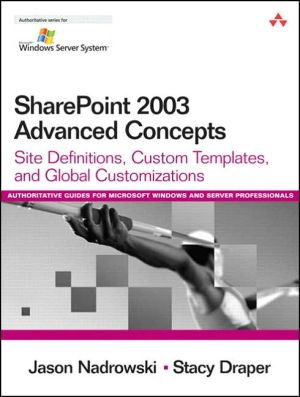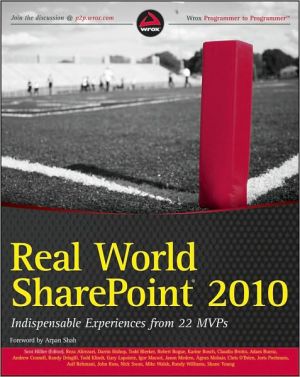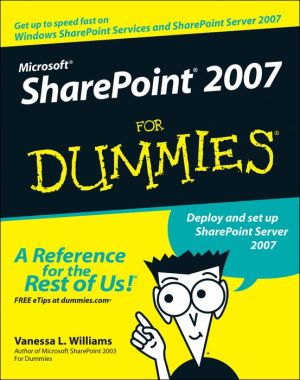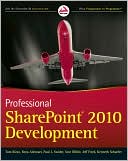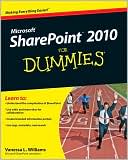SharePoint 2003 Advanced Concepts: Site Definitions, Custom Templates, and Global Customizations
In SharePoint 2003 Advanced Concepts, two world-class SharePoint consultants show how to make SharePoint “jump through hoops” for you–and do exactly what you want.\ Jason Nadrowski and Stacy Draper have built some of the most diverse SharePoint enterprise implementations. Now, drawing on their extraordinary “in the trenches” experience, they present solutions, techniques, and examples you simply won’t find anywhere else.\ SharePoint 2003 Advanced Concepts addresses every facet of SharePoint...
Search in google:
In SharePoint 2003 Advanced Concepts, two world-class SharePoint consultants show how to make SharePoint “jump through hoops” for you–and do exactly what you want. Jason Nadrowski and Stacy Draper have built some of the most diverse SharePoint enterprise implementations. Now, drawing on their extraordinary “in the trenches” experience, they present solutions, techniques, and examples you simply won’t find anywhere else. SharePoint 2003 Advanced Concepts addresses every facet of SharePoint customization, from site definitions and templates to document libraries and custom properties. The authors cover both Windows SharePoint Services and SharePoint Portal Server 2003 and illuminate SharePoint’s interactions with other technologies–helping you troubleshoot problems far more effectively. Next time you encounter a tough SharePoint development challenge, don’t waste time: get your proven solution right here, in SharePoint 2003 Advanced Concepts. • Construct more powerful site and list templates • Control how SharePoint uses ghosted and unghosted pages • Use custom site definitions to gain finer control over your site • Build list definitions with custom metadata, views, and forms • Troubleshoot WEBTEMP, ONET. • Create custom property types to extend SharePoint’s functionality • Integrate with other systems and SharePoint sites so that you can use their information more effectively • Customize themes and interactive Help, one step at a time • Customize email alerts and system notifications • Extend the capabilities of document libraries • Control document display and behavior based on extensions
PrefacePreface\ There is a lot to SharePoint Portal Server and Windows SharePoint Services; even so, it is finite. We originally wanted to write a book about everything that SharePoint has to offer. As we were writing, books kept coming out, more and more content was available on the Internet, and we didn't want to write about topics that were covered well elsewhere. What we ended up with is a book jammed full of information that was noticeably absent from the SharePoint community.\ The techniques we talk about in this book were born out of necessity. We worked on completely different projects and realized that we were having the same problems. Not readily finding solutions to our problems, we discovered the need for this content. When we approached Addison-Wesley, there were already several books on the market. The publisher wanted to know why our book was going to be a good one. The answer was pretty simple—we have lived and breathed the product and have had to solve real business problems. We've been in the trenches with the product and know it intimately. We know what works and what doesn't work in the real world. We're not a couple of authors who have friends or went to college with folks in the product group. We are hands-on architects/programmers who know the product and how to will it to our ways.\ To keep things interesting for both the reader and for us, we wrote in a way that will expose you, the reader, to many of the inner workings of SharePoint without becoming a boring reference manual. You'll see problems that we tried to solve and what we did to come up with solutions for those problems. Your problems might not be exactly thesame as ours. As a matter of fact, I'm sure the problems won't be identical. But you should find that the problems you encounter with SharePoint in your enterprise can be solved with the solutions we describe. Exposure to these solutions will enable you to explore other areas of SharePoint otherwise hidden from view.\ The SharePoint product family seems to touch everything in the Microsoft world. The SharePoint product line relies on servers such as the Windows Server 2003 and SQL Server and leans heavily on Active Directory, ASP.net, and even a lot of JavaScript. From the user interface side, the Office products make an appearance. All these technologies make SharePoint a tough animal to deal with in terms of a technical tool set. Working with SharePoint sometimes takes relying on a small army of highly skilled folks to pull off a successful implementation or modification—point being, the technologies that are used are many. This certainly shouldn't be your first technology book and probably shouldn't even be the first SharePoint book you own. This book is for people who have wrestled with SharePoint and have tried to make SharePoint behave in a way that it probably wasn't originally designed to do. The person who will benefit most from a book like this might be saying something like, "If I could just make it do this one thing, then everything else would just fall together!"Organization of This Book\ We organized the content of the book into the following chapters.\ Chapter 1: Custom Templates\ Site templates and list templates are something that end users can work with. They are a great way to empower end users. Sometimes little things can be done to make the SharePoint experience go a long way. This chapter demonstrates the ins and outs of working with site templates and list templates.\ Chapter 2: Site Definitions\ Site definitions are not the most intuitive thing. In fact, site definitions are quite different from traditional ASPX applications. Chapter 2 explains the use and development of site definitions, while navigating around their more common pitfalls. In this chapter, you'll work with several configuration files. You'll get down to the technical details to make SharePoint a more pliable application.\ Chapter 3: Site Definitions: Exploring List Definitions\ If it weren't for lists, there wouldn't be much of a SharePoint product at all. Lists are one of those great features found in SharePoint that empower users to create what they need. Even though list definitions are part of site definitions, there is so much to know about lists that it warrants a dedicated chapter. This chapter exposes you to every detail of creating a list definition.\ Chapter 4: Customizing and Implementing Property Types in Windows SharePoint Services\ Lists are great things. They enable users to create a table of information fairly quickly and present it to other users in a manner that is readily consumable. Of course, there are a couple shortcomings. The first is a lack of a custom property type. The second and most common shortcoming is the need to integrate with other systems. The inability to pull in key information from another system or even another WSS site can be a showstopper. This chapter shows you how to create custom properties—be it for retrieving information stored in another system or for other special functionality.\ Chapter 5: Global Customizations\ We close the book with a chapter that applies to SharePoint holistically. Customizing themes and help are explained thoroughly. Other common customizations, such as email alerts, and system notifications, such as the site collection retention warning, are also covered. Document libraries are quite powerful as they are, but there is always room for improvement. Detailed information is provided to make documents display and behave differently based on their extensions.\ Appendix: Custom_JS.ASPX\ The appendix includes a complete listing of the CUSTOM_JS.ASPX file that is discussed in Chapter 4.Notations\ The LCID figures prominently in SharePoint's physical and virtual paths. The LCID for your deployment is based on the particular SharePoint media you have procured. The English version of SharePoint has an LCID of 1033. Because this book was authored in English, we will go out on a limb and presume that most people who read this book have the English version of SharePoint. So, if you are trying to access a path that has 1033 in it, and it doesn't seem to exist, substitute 1033 for your LCID. Available Language Packs for SharePoint\ \ \ \ \ \ \ \ Language\ \ \ SharePoint LCID\ \ \ \ \ English\ \ \ 1033\ \ \ \ \ Japanese\ \ \ 1041\ \ \ \ \ German\ \ \ 1031\ \ \ \ \ French\ \ \ 1036\ \ \ \ \ Spanish\ \ \ 3082\ \ \ \ \ Italian\ \ \ 1040\ \ \ \ \ Dutch\ \ \ 1043\ \ \ \ \ Swedish\ \ \ 1053\ \ \ \ \ Danish\ \ \ 1030\ \ \ \ \ Finnish\ \ \ 1035\ \ \ \ \ Norwegian\ \ \ 1044\ \ \ \ \ Portuguese\ \ \ 2070\ \ \ \ \ Brazilian Portuguese\ \ \ 1046\ \ \ \ \ Polish\ \ \ 1045\ \ \ \ \ Turkish\ \ \ 1055\ \ \ \ \ Czech\ \ \ 1029\ \ \ \ \ Hungarian\ \ \ 1038\ \ \ \ \ Greek\ \ \ 1032\ \ \ \ \ Russian\ \ \ 1049\ \ \ \ \ Korean\ \ \ 1042\ \ \ \ \ Simplified Chinese\ \ \ 2052\ \ \ \ \ Traditional Chinese\ \ \ 1028\ \ \ \ \ Arabic\ \ \ 1025\ \ \ \ \ Hebrew\ \ \ 1037\ \ \ \ \ Thai\ \ \ 1054\ \ \ \ \ © Copyright Pearson Education. All rights reserved.
1Custom templates12Site definitions233Site definitions : exploring list definitions934Customizing and implementing property types in Windows Sharepoint services1355Global customizations207AppCustomöJS.ASPX241
